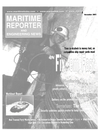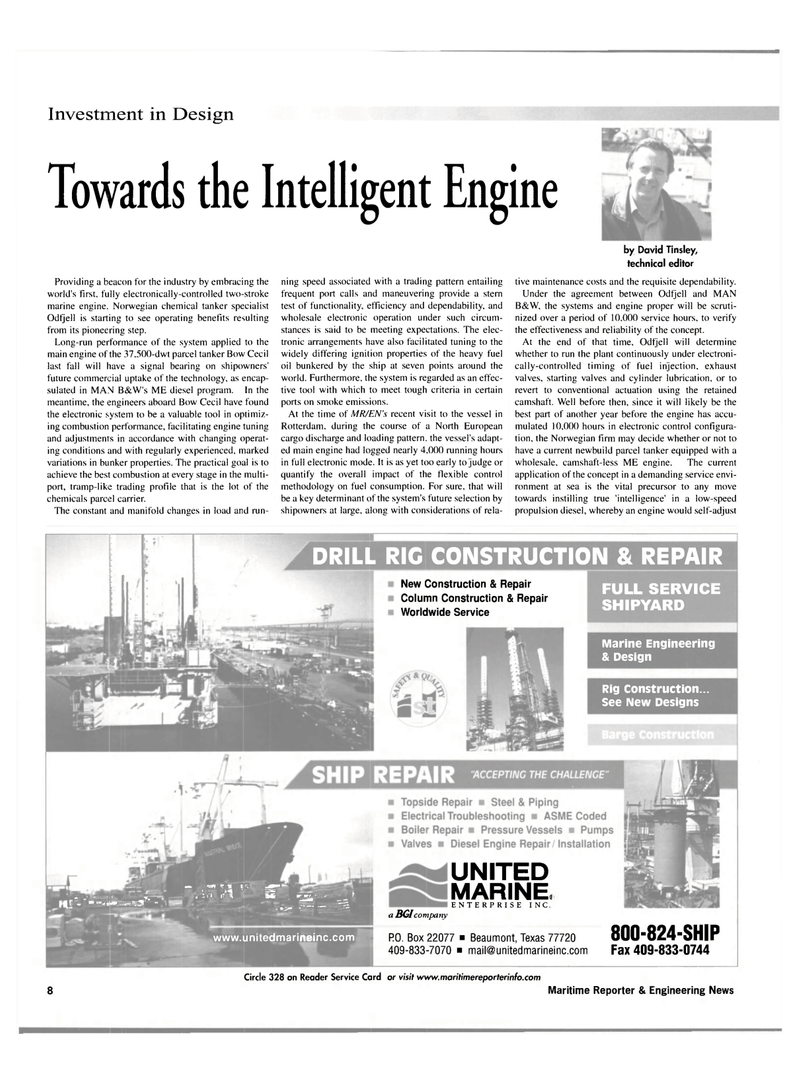
Page 8: of Maritime Reporter Magazine (November 2001)
Read this page in Pdf, Flash or Html5 edition of November 2001 Maritime Reporter Magazine
Investment in Design
Towards the Intelligent Engine
Providing a beacon for the industry by embracing the world's first, fully electronically-controlled two-stroke marine engine. Norwegian chemical tanker specialist
Odtjell is starting to see operating benefits resulting from its pioneering step.
Long-run performance of the system applied to the main engine of the 37,500-dwt parcel tanker Bow Cecil last fall will have a signal bearing on shipowners' future commercial uptake of the technology, as encap- sulated in MAN B&W's ME diesel program. In the meantime, the engineers aboard Bow Cecil have found the electronic system to be a valuable tool in optimiz- ing combustion performance, facilitating engine tuning and adjustments in accordance with changing operat- ing conditions and with regularly experienced, marked variations in bunker properties. The practical goal is to achieve the best combustion at every stage in the multi- port, tramp-like trading profile that is the lot of the chemicals parcel carrier.
The constant and manifold changes in load and run- ning speed associated with a trading pattern entailing frequent port calls and maneuvering provide a stern test of functionality, efficiency and dependability, and wholesale electronic operation under such circum- stances is said to be meeting expectations. The elec- tronic arrangements have also facilitated tuning to the widely differing ignition properties of the heavy fuel oil bunkered by the ship at seven points around the world. Furthermore, the system is regarded as an effec- tive tool with which to meet tough criteria in certain ports on smoke emissions.
At the time of MR/EN's recent visit to the vessel in
Rotterdam, during the course of a North European cargo discharge and loading pattern, the vessel's adapt- ed main engine had logged nearly 4.000 running hours in full electronic mode. It is as yet too early to judge or quantify the overall impact of the flexible control methodology on fuel consumption. For sure, that will be a key determinant of the system's future selection by shipowners at large, along with considerations of rela- by David Tinsley, technical editor tive maintenance costs and the requisite dependability.
Under the agreement between Odfjell and MAN
B&W. the systems and engine proper will be scruti- nized over a period of 10.000 service hours, to verify the effectiveness and reliability of the concept.
At the end of that time, Odtjell will determine whether to run the plant continuously under electroni- cally-controlled timing of fuel injection, exhaust valves, starting valves and cylinder lubrication, or to revert to conventional actuation using the retained camshaft. Well before then, since it will likely be the best part of another year before the engine has accu- mulated 10.000 hours in electronic control configura- tion, the Norwegian firm may decide whether or not to have a current newbuild parcel tanker equipped with a wholesale, camshaft-less ME engine. The current application of the concept in a demanding service envi- ronment at sea is the vital precursor to any move towards instilling true 'intelligence' in a low-speed propulsion diesel, whereby an engine would self-adjust
DRILL RIG CONSTRUCTION & REPAIR
New Construction & Repair
Column Construction & Repair
Worldwide Service
FULL SERVICE
SHIPYARD
Marine Engineering & Design
Rig Construction...
See New Designs nx~-''•j.JHU * • — jmm . '; r W . 1- * -ft. --- - 2 www.unitedmarineinc.com
UNITED MARINE.
ENTERPRISE INC. a BGIcompany
R0. Box 22077 • Beaumont, Texas 77720 800-824-SHIP 409-833-7070 • [email protected] Fax 409-833-0744 8
Circle 328 on Reader Service Card or visit www.maritimereporterinfo.com
Maritime Reporter & Engineering News

 7
7

 9
9
